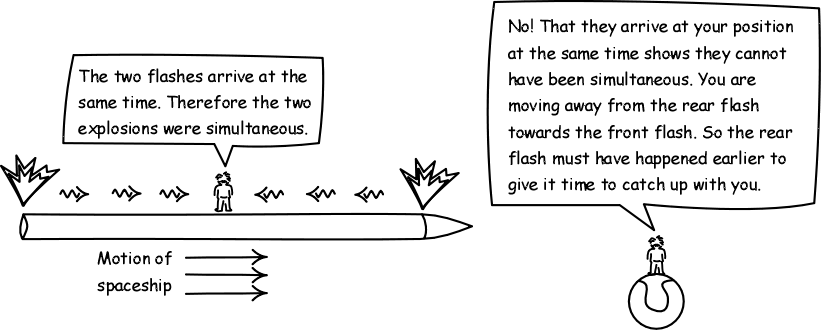| HPS 0410 |
Einstein for Everyone |
Spring 2008 |
Back to main course page
Assignment 5: Spacetime
For submission Monday February 11, Tuesday February 12
1. Draw a spacetime diagram with the
following elements. Be sure to label each one clearly.
An event O.
A worldline of an observer A that passes through O.
The light cone at O.
The hypersurface of all events simultaneous with O (for observer A).
An event Epast which is in the past of O and can causally affect
O.
An event Efuture which is in the future of O and can be causally
affected by O.
An event Eelsewhere which is outside the light cone of O and
cannot be causally affected by O.
A timelike curve through O.
A spacelike curve through O.
A lightlike curve through O.
2. On the
spacetime diagrams below:
For discussion in the recitation
A. The
relativity of simultaneity is revealed most simply in the following thought
experiment in which two observers in relative motion judge the timing of two
explosions by means the light signals they produce:

Draw a spacetime diagram of this experiment, indicating:
The planet observer's worldline and associated hypersurfaces of
simultaneity.
The spaceship observer's worldline and associated hypersurfaces of
simultaneity.
The worldlines of the front and rear of the spaceship.
The two explosion events.
The light signals emitted by the explosions.
B. At sunrise
of Day 1, a monk commences a long walk up the narrow, winding road from the
monastery in the valley to the mountain top. It is a hard, tiring climb, so
he stops frequently to rest and even reverses his direction from time to
time. He arrives at the mountain top just at the moment of sunset. At sunrise
on Day 2, the monk commences the return journey. This time the journey is far
easier. Rather than hurry to complete it quickly, the monk decides to pause
frequently to admire the wildflowers, inhale the mountain air and absorb the
splendor of the view. He arrives in the valley at the moment of sunset.
Is there any moment on the two days at which the monk is in exactly the
same position on the road?
At first it seems impossible to determine an answer to this question from
the information given. Whether there is such a moment seems to depend on the
details of the monk's progress up and down the mountain. Drawing spacetime
diagrams rapidly solves the problem, however. To see how, draw plausible
world lines for the monk's two journeys on the spacetime diagrams here.

Explain how they make it obvious that the moment specified in the question
must always exist no matter what the details of the monk's progress. (Hint:
To see this, imagine the two spacetime diagrams superimposed.)




